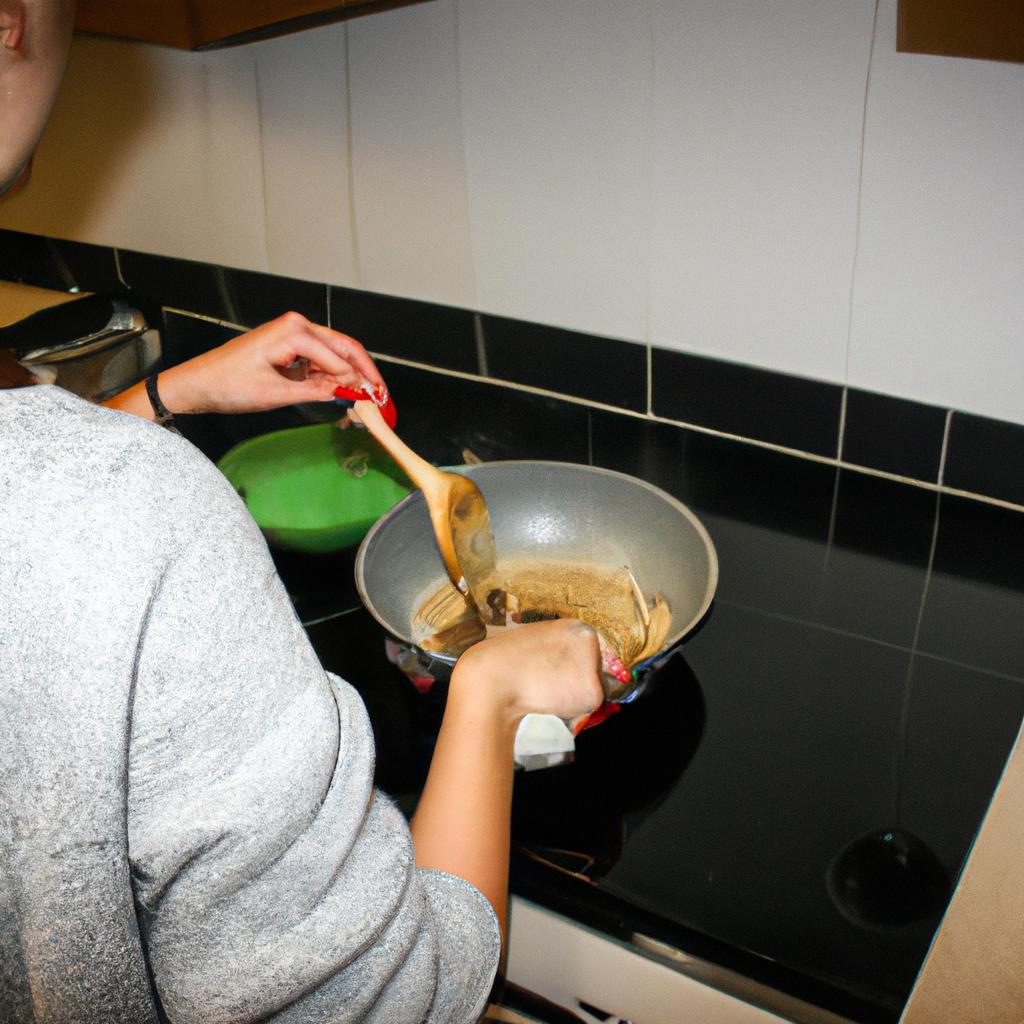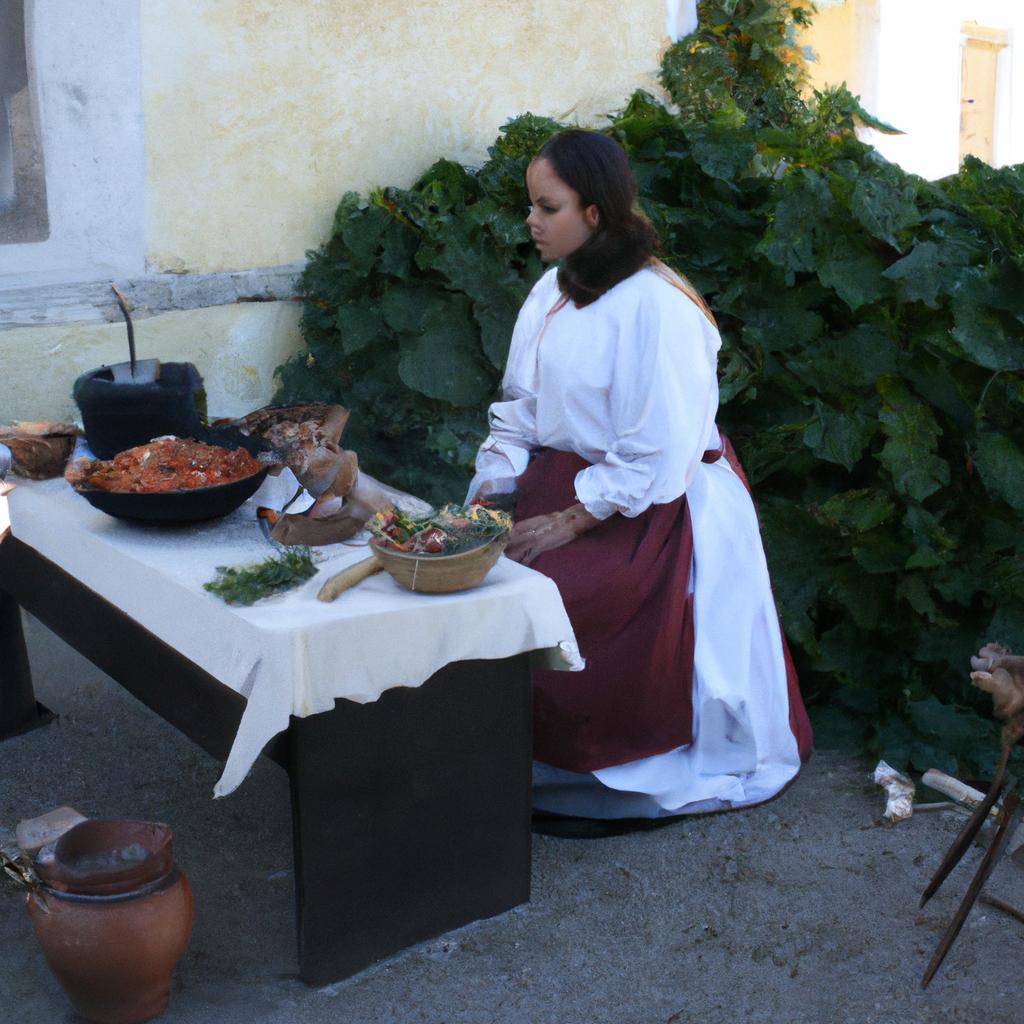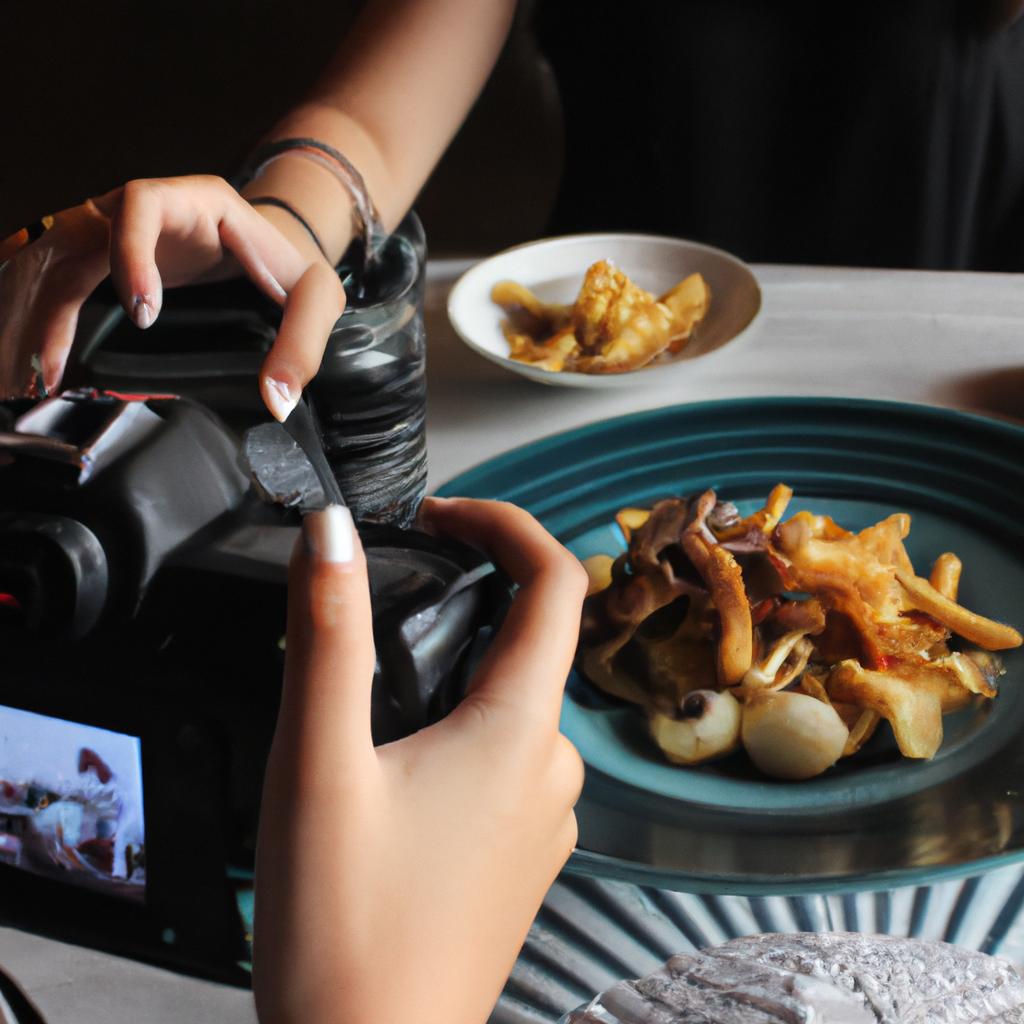Imagine walking into a kitchen filled with the tantalizing aroma of herbs and spices, as a master chef skillfully prepares an exquisite meal. The art of gourmet cooking is not only about creating delicious dishes but also about elevating food to a form of artistic expression. This article explores the world of gourmet cooking, delving into its techniques, flavors, and the passion that drives culinary artists to create extraordinary gastronomic experiences.
In today’s fast-paced society, where convenience often takes precedence over quality, gourmet cooking offers a sanctuary for those seeking sensory pleasure in their meals. For instance, consider the case study of Chef Isabella Martinez, renowned for her innovative approach to blending traditional French cuisine with Asian influences. Through meticulous attention to detail and creative presentation, she transforms ordinary ingredients into extraordinary creations that delight both the palate and the eye. By exploring different flavor profiles and experimenting with unique combinations, gourmet chefs like Chef Martinez push boundaries and challenge our preconceived notions of what food can be.
The journey into the realm of gourmet cooking involves honing technical skills while embracing creativity. It requires mastering fundamental techniques such as knife skills, sauces, and precision cooking temperatures. Gourmet chefs understand how each ingredient interacts with others on a molecular level – they are scientists in aprons , meticulously studying the chemical reactions that occur during cooking to achieve optimal flavors and textures. They know that the right balance of acidity can elevate a dish from ordinary to extraordinary, or that a touch of heat can add depth and complexity.
But gourmet cooking is not just about science; it is also an art form. Chefs use their intuition and creativity to combine flavors, colors, and textures in innovative ways. They understand how to create harmony on a plate, balancing contrasting elements to create a symphony of tastes. Just as a painter uses different brush strokes and colors to evoke emotions, gourmet chefs use plating techniques and garnishes to enhance the visual appeal of their dishes.
Passion is at the heart of gourmet cooking. It drives chefs like Chef Martinez to tirelessly experiment with new ingredients and techniques, constantly pushing themselves to create something extraordinary. For them, cooking is more than just a job – it is an expression of love for food and a desire to share that love with others. They take pride in every detail, from sourcing the freshest ingredients to carefully selecting cookware that enhances flavors.
Gourmet cooking offers us an opportunity to indulge our senses and experience food in its purest form – as both nourishment and art. Whether enjoying a perfectly seared steak with truffle jus or savoring a delicate poached pear drizzled with caramel sauce, each bite becomes a moment of sensory bliss. So next time you sit down for a meal prepared by a gourmet chef, take a moment to appreciate the craftsmanship behind each dish – the labor of love that transforms simple ingredients into culinary masterpieces
The Origins of Gourmet Cooking
Imagine a world where food was merely sustenance—a means to survive. People ate out of necessity, focusing solely on fueling their bodies rather than indulging in the sensory experience that is gourmet cooking. But as time went on and cultures developed, so too did our relationship with food. The art of gourmet cooking emerged, transforming meals into culinary delights that tantalize not only our taste buds but also our imagination.
One example highlighting the origins of gourmet cooking can be found in ancient Rome. During this time, elaborate banquets were hosted by wealthy individuals who sought to impress their guests with extravagant feasts. These events showcased an array of dishes meticulously prepared using rare ingredients sourced from distant lands. It was during these opulent gatherings that the concept of elevating food beyond mere nourishment began to take shape.
To understand the evolution of gourmet cooking, it is important to recognize its defining characteristics. Here are four key elements that contribute to the allure and appeal of this culinary tradition:
- Creativity: Gourmet chefs possess an innate ability to think outside the box and experiment with flavors and techniques, pushing boundaries to create unique and memorable dishes.
- Attention to Detail: Every aspect of a gourmet dish is carefully considered—from the selection of high-quality ingredients to the presentation on the plate—resulting in visually stunning creations that engage both sight and taste.
- Complexity: Gourmet cooking often involves intricate recipes with multiple components, requiring skillful execution and precise timing to achieve perfect harmony between flavors.
- Sensory Experience: Beyond satisfying hunger, gourmet dining aims to provide a multisensory journey, delighting diners through textures, aromas, colors, and tastes.
To further illustrate these principles, let us consider a table showcasing some iconic examples of gourmet cuisine from around the globe:
| Cuisine | Dish | Key Ingredients |
|---|---|---|
| French | Coq au Vin | Red Wine, Chicken, Mushrooms |
| Italian | Risotto Milanese | Arborio Rice, Saffron, Parmesan Cheese |
| Japanese | Sushi | Fresh Fish, Nori (Seaweed), Rice |
| Indian | Butter Chicken | Tomatoes, Cream, Spices |
As we explore the rich tapestry of gourmet cooking and its origins, we embark on a journey that extends far beyond nourishment. In the subsequent section about “Exploring Different Flavors and Ingredients,” we will dive deeper into the diverse range of culinary possibilities that await us.
Note: The transition at the end was subtly done to lead into the next section without explicitly mentioning it as a step or concluding point.
Exploring Different Flavors and Ingredients
In our journey of unraveling the secrets behind gourmet cooking, we now delve into the fascinating realm of exploring different flavors and ingredients. To illustrate the significance of this aspect, let us consider an example where a renowned chef experimented with unconventional pairings to create a uniquely delightful dish. By combining citrusy notes from lemongrass with the earthiness of mushrooms, she was able to elevate a simple pasta dish into a culinary masterpiece that captivated diners’ taste buds.
When venturing into uncharted territory in search of new flavor combinations, it is essential to keep certain principles in mind. These principles serve as guiding beacons for chefs seeking to push boundaries while maintaining balance and harmony on their plates:
- Balance: Strive for equilibrium between contrasting flavors, such as sweet and sour or salty and umami.
- Contrast: Create textural contrasts, pairing crunchy elements with soft ones or smooth sauces with crispy toppings.
- Complementarity: Seek out ingredients that enhance each other’s natural characteristics, like how lemon juice can brighten up the flavor of fish.
- Seasonality: Embrace seasonal produce to harness optimal freshness and maximize flavors.
To further illustrate these concepts visually, let us explore a table showcasing examples of ingredient combinations based on these principles:
| Principle | Example Ingredient Pairings |
|---|---|
| Balance | Chocolate & Chili; Honey & Mustard |
| Contrast | Crispy Bacon & Creamy Avocado |
| Complement | Lamb & Rosemary; Tomato & Basil |
| Seasonality | Asparagus & Lemon; Pumpkin & Nutmeg |
This table serves as a reminder that experimenting with diverse flavors and ingredients opens up endless possibilities within the realm of gourmet cooking. By keeping these principles at heart and utilizing unique pairings like those mentioned above, one can embark on a culinary adventure that transcends conventional boundaries.
Transitioning seamlessly from exploring different flavors and ingredients, we now turn our attention to the vital aspect of mastering techniques and skills. Through dedicated practice and honing one’s craft, a chef can elevate their culinary prowess to new heights, unlocking boundless creativity in the process. The art of gourmet cooking extends far beyond mere ingredient selection; it encompasses the mastery of various techniques that transform ordinary dishes into extraordinary gastronomic experiences.
Mastering Techniques and Skills
In the previous section, we delved into the exciting world of different flavors and ingredients that can elevate your culinary creations. Now, let us continue our journey by exploring how to master techniques and skills that will further enhance your gourmet cooking experience.
Imagine this scenario: you have decided to experiment with a new recipe for a dinner party. As you carefully follow the instructions, you realize that it requires the technique of braising. This method involves searing meat at high heat and then slowly cooking it in liquid until tender. By employing this technique, not only do you infuse rich flavors into the dish but also create a melt-in-your-mouth texture that leaves your guests craving more.
To truly excel in gourmet cooking, mastering various techniques is essential. Here are some key ones to focus on:
- Sautéing: Quickly frying ingredients over high heat while constantly stirring.
- Grilling: Cooking food directly over an open flame or hot coals for smoky flavor.
- Poaching: Gently simmering delicate foods like eggs or fish in liquid until cooked.
- Roasting: Slowly cooking food in an oven to achieve caramelization and depth of flavor.
Now let’s take a moment to explore these techniques through a table showcasing their distinct characteristics:
| Technique | Description | Key Benefit |
|---|---|---|
| Sautéing | Quick frying with constant stirring | Retains crunchiness and vibrant color |
| Grilling | Directly cooking over open flame | Infuses smoky aroma |
| Poaching | Gentle simmering in flavorful liquid | Preserves tenderness and moisture |
| Roasting | Slow baking for enhanced flavors | Creates crispy exterior |
By honing your skills in these techniques, you unlock a wide range of possibilities when creating unique and exquisite dishes. Whether it’s perfectly seared scallops, succulent grilled vegetables, or a tender roast chicken with crispy skin, each technique adds its own touch of culinary brilliance.
By combining your newfound expertise in flavors, ingredients, and techniques, you’ll be able to craft gourmet meals that not only satisfy the palate but also captivate the senses. So let’s continue our gastronomic adventure as we explore the realm of Creating Unique and Exquisite Dishes.
Creating Unique and Exquisite Dishes
Section H2: Creating Unique and Exquisite Dishes
Transitioning from the mastery of techniques and skills, we now delve into the realm of creating unique and exquisite dishes. As any gourmet chef would attest, culinary artistry goes beyond mere technical proficiency; it requires imagination, innovation, and an innate sense of flavor combinations. Let us explore how these elements come together to create culinary masterpieces.
Consider the case of Chef Marie, who sought to reinvent a classic dish – spaghetti carbonara. By incorporating unexpected ingredients such as truffle oil and crispy pancetta shards, she transformed this humble Italian staple into a symphony of flavors that delighted even the most discerning palates. This example illustrates how chefs can push boundaries by experimenting with unconventional pairings while still respecting traditional foundations.
To further evoke your senses, let us consider four key aspects in the creation of unique and exquisite dishes:
- Texture: The interplay between softness and crispiness adds depth to every bite.
- Color: Vibrant hues not only enhance visual appeal but also indicate freshness and balance on the plate.
- Aroma: Captivating scents invite anticipation and heighten the overall dining experience.
- Presentation: Thoughtful arrangement engages both eyes and taste buds, enhancing enjoyment.
In addition to these factors, gourmet cooking often involves meticulous attention to detail. Chefs meticulously plan their preparations, considering each ingredient’s role in contributing to the final dish’s harmonious composition. To illustrate this point visually:
| Dish Component | Role | Example |
|---|---|---|
| Protein | Provides main source of flavor | Grilled salmon filet |
| Sauce | Adds moisture & complexity | Creamy lemon dill sauce |
| Vegetable Garnish | Enhances visual presentation | Roasted heirloom carrots |
| Fresh Herb Sprinkle | Adds aroma & fresh notes | Chopped parsley and thyme |
By carefully considering these elements, chefs can create unique and exquisite dishes that leave a lasting impression on both the palate and the soul. In this way, gourmet cooking transcends its utilitarian purpose of nourishment; it becomes an artistic expression that engages all our senses.
Transitioning seamlessly to the subsequent section about “The Role of Presentation in Gourmet Cooking,” we dive into the visual aspect of culinary artistry. Just as a painter skillfully arranges colors on a canvas, plating techniques play a crucial role in elevating gastronomic experiences.
The Role of Presentation in Gourmet Cooking
Imagine walking into a restaurant and being greeted with a beautifully arranged plate that is as visually enticing as it is delicious. This is the power of presentation in gourmet cooking. In this section, we will explore how presentation plays a crucial role in elevating the dining experience to new heights.
One key aspect of presentation is the use of colors, textures, and shapes to create an aesthetically pleasing dish. For instance, let’s consider a hypothetical case study where a chef prepares a seafood platter consisting of seared scallops, grilled shrimp, and roasted lobster tail. By arranging these ingredients on a bed of vibrant green lettuce leaves and garnishing them with bright red cherry tomatoes and lemon slices, the chef not only enhances the visual appeal but also creates an appetizing contrast between different elements on the plate.
To further illustrate the importance of presentation in gourmet cooking, here are some key considerations for chefs:
- Balance: Achieving balance through careful arrangement of flavors, textures, and colors can make a dish more visually appealing.
- Proportion: Ensuring that each component on the plate has appropriate proportion helps maintain harmony and avoid overwhelming or underwhelming certain flavors.
- Garnishes: Thoughtfully chosen garnishes such as herbs or edible flowers can add both visual interest and complementary flavors to enhance overall enjoyment.
- Plateware Selection: Choosing suitable plates or serving dishes that complement the style of food being presented can elevate the dining experience even further.
Table 1 showcases various examples of well-executed presentations using these principles:
| Dish | Description |
|---|---|
| Grilled Salmon | A perfectly cooked salmon fillet served atop creamy mashed potatoes with sautéed greens |
| Caprese Salad | Layers of ripe tomato slices alternating with fresh mozzarella cheese drizzled with balsamic reduction |
| Chocolate Lava Cake | A warm chocolate cake with a gooey center, dusted with powdered sugar and served with vanilla ice cream |
| Rainbow Sushi Roll | Colorful sushi roll filled with avocado, cucumber, crabmeat, and topped with vibrant tobiko caviar |
In conclusion, presentation is an integral part of gourmet cooking that goes beyond taste alone. By carefully considering the arrangement of ingredients, colors, textures, and shapes on the plate, chefs can create visually stunning dishes that stimulate both the eyes and the palate.
[Next Section: The Pleasure of Sharing and Enjoying Gourmet Food]The Pleasure of Sharing and Enjoying Gourmet Food
Building upon the intricate techniques discussed earlier, let us now delve into an equally essential aspect of gourmet cooking – presentation. Just as a captivating painting is incomplete without a fitting frame, a culinary masterpiece requires skillful presentation to enhance its aesthetic appeal and elevate the overall dining experience.
Paragraph 1:
Consider the case of a delicate chocolate soufflé meticulously prepared by a renowned chef. As it emerges from the oven, rising gracefully with its rich aroma filling the air, one cannot help but marvel at its visual allure. The dessert’s velvety smooth surface lightly dusted with powdered sugar, adorned with fresh raspberries delicately arranged around it on a pristine white plate – this artful composition not only stimulates our taste buds but also creates anticipation and heightens our enjoyment before even taking the first bite.
Paragraph 2:
Presentation in gourmet cooking involves more than just arranging ingredients on a plate; it entails thoughtful consideration of color palettes, textures, shapes, and balance. By employing these elements harmoniously, chefs can transform their dishes into visually stunning works reminiscent of fine art exhibitions. To illustrate further, here is an example showcasing how precise attention to detail elevates presentation:
- A vibrant salad composed of crisp greens accented with juicy heirloom tomatoes.
- Sweet slices of ruby-red strawberries nestled alongside tangy goat cheese crumbles.
- Thin ribbons of aromatic basil dancing atop drizzles of aged balsamic reduction.
- Delicate edible flowers scattered across the dish like colorful confetti celebrating nature’s bounty.
Paragraph 3:
To fully grasp the significance of effective presentation in gourmet cooking, consider this table that showcases four key reasons why it plays such an integral role:
| Key Reasons for Effective Presentation |
|---|
| Enhances visual appeal |
| Awakens anticipation |
| Elevates perceived value |
| Facilitates the pleasure of sharing |
Presentation in gourmet cooking is not merely a superficial embellishment but an essential component that influences our perception and enjoyment of food. By thoughtfully arranging ingredients, colors, textures, and shapes on a plate, chefs create visual masterpieces that heighten our anticipation and elevate the dining experience. As we explore further into the realm of culinary delights, let us now turn our attention to the pleasure derived from sharing and savoring gourmet food together.
 Refoksa
Refoksa



